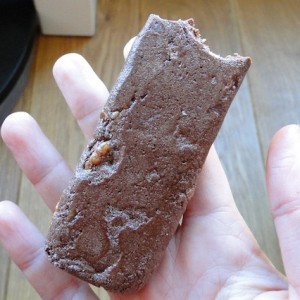
Here is a homemade quest type bar....the best I have found. Let me know how you like them.
You can add anything you like to get the flavor you want ex. Coconut, chocolate chips, nuts etc. just use the basic recipe
Ok first measure three tablespoons VitaFiber into a saucepan & heat over med heat just till bubbling.... In a bowl mix 1 scoop of protein powder & whatever kind of extras for the kind your making...ex. Chic chips, nuts, peanut butter chips etc. ......I tablespoon of whatever......add bubbling vita fiber to it mix......transfer to Saran Wrap & shape bar........put in fridge for 30 min..... That's it you just made your own Quest bar.....enjoy.
for all bars mix all ingredience wrap in Saran wrap to shape into bars ( you can make mini bars too) & put in fridge till set.
Simple Chocolate Protein Bar
– 3 tbsp VitaFiber syrup
– 1 scoop protein powder ( I like BSN SYNTHA-6 Isolate)
– 1 tsp cocoa
– 1 tsp vanilla extract
Ingredient for the low-carb low-fat bar
Low-carb homemade Quest bars
The nutrition facts for this homemade bar: 166.4 kcal, 23.3 g of protein, 25.8 g of carbs, 0.6 g of sugar, 0.6 g of fat, 22.1 g of fiber. (I calculated these values taking into account 2 kcal per gram of resistant oligosaccharides and 4 kcal per gram of digestible carbs).
So yes, you basically get the same nutrition facts as Quest bars, but your bars can be lower in fat if you wish. A typical Quest bar is around 200 kcal, 20 g protein, 22 g carbs, 1 g sugar, 9 g fat and 18 g fiber.
I’ve also tried a brownie-like bar, using a square of dark chocolate and 2 walnuts:
This one is pictured on the blog
Ingredients for the chocolate brownies
Homemade Chocolate Quest bars
Nutrition facts for the brownie bar: 265 kcal, 25.2 g protein, 28.7 g carbs, 3.3 g sugar, 9.6 g fat, 23.2 g fiber.
Banana Nut Muffin Bar
– 1 scoop vanilla protein (any type of protein you like..... I use BSN ISOBURN Vanilka Ice Cream)
– 3 tbsp VitaFiber
– 1 tsp cashew butter (or any other nut butter)
– 2 walnuts
– a few drops of banana and caramel flavorings
Ingredients for the banan muffin bars
Banana Nut Muffin Bar
Nutrition facts for the Banana Nut Muffin bar: 237 kcal, 24.9 g protein, 26.8 g carbs, 0.3 g sugar, 7.6 g fat, 22.3 g fiber.
Blueberry Cheesecake Bar
– 1 scoop vanilla protein powder
– 3 Tbsp vita fiber
– 1 tsp cashew butter
– a couple of fresh blueberries
– a few drops of cheesecake flavoring
Ingredients for the blueberry cheesecake bar
Blueberry Cheesecake Bar
Nutrition facts: 204 kcal, 24 g protein, 30.7 g carbs, 3.6 g sugar, 2.5 g fat, 22.5 g fiber.
Peanut Butter & Jelly bar
– 1 scoopvanilla protein
– 3 tbsp VitaFiber
– 1 tbsp peanut butter
– a few drops of cranberry flavoring
Ingredients for the peanut butter sandwitch bar
Peanut butter protein bar
Nutrition facts: 255 kcal, 27 g protein, 28 g carbs, 1.45 g sugar, 8.4 g fat, 22.9 g fiber.
Using IMO-powder
What about VitaFiber powder, what can you do with it? You can use it as a sugar substitute for baking. I’ve been trying to come up with low-carb meringues for a long time. Until now, the result was always a disaster, regardless of the kind of sugar substitute (erythritol, xylitol or others). But the VitaFiber powder acted as an excellent sugar substitute
Low-carb meringue
Texture of the low-carb meringue
Using egg white powder in combination with VitaFiber powder, you can also make a very fluffy, super low-carb but super thick frosting to decorate cupcakes. Besides the fitness-oriented or low-carb folks, I think the texture-giving properties of the product would be very interesting for people who are into cake-decorating crafts.
My verdict on VitaFiber / IMO
When I compared ‘classic’ homemade protein bars with homemade protein bars using IMO, I think the biggest advantage of IMO is that it saves a few calories: when you’re making homemade protein bars, you have to have a binding agent: either a sugary syrup like agave or honey, or some sugar-free syrup made with an artificial sweetener, or a fat ingredient like a nut butter. IMO allows you to put a lot less of these ingredients to create solid bars that don’t need to be kept refrigerated.
And if you’re really into low-carb, you can make a bar just by combining 2 tbsp of VitaFiber and 1 scoop of your favorite protein powder. This kind of simple bar takes less space than a protein shaker bottle and won’t break down in your gym bag.
As opposed to buying ready-made Quest bars or OhYeah Victory bars, the biggest advantage is that you are able to control every ingredient that goes into your bars. For example, I don’t think I need additional sweeteners or salt. I find Quest bars too salty. I also like to be able to choose the kind of protein I put in (for example egg white protein powder or hemp protein instead of whey). So all-in-all, I’d rather take 5 minutes to make a batch of my own low-sodium Quest bars.
Quest bars or OhYeah Victory bars cost me 3 euro per bar, or 32 euro for a package of 12 bars here in Europe. The cost of homemade bars using IMO is lower.
Where can you buy IMO-syrup?
Bioneutra.ca usually sells to wholesalers but has opened an small online shop for customers: http://vitafiber.myshopify.com. (This isn’t an affiliate link, I don’t get anything if you buy on their site). Prices are in Canadian dollars, and one kilo syrup costs $14 CAD.
I have found they now have other sites that sell IMO's not called VitaFiber but I personally have never tried it so I can't say if it would be the same, although I would think so.